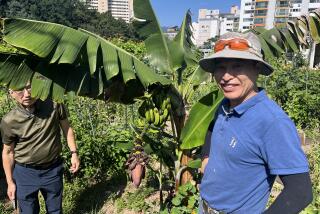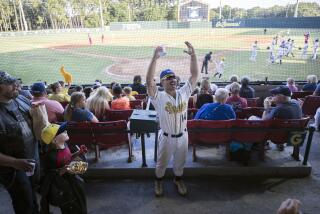Height of the Moment
- Share via
Welcome to the tropics. Native to Asia, bananas are now the fourth-largest global fruit crop, growing in most of the world’s tropics (as well as Iceland, in ground heated by geysers). Alexander the Great carried them from India to the West circa 300 BC. A few centuries later, the plant landed, via Polynesian canoe, in Hawaii, where its various parts have fed, clothed and thatched the roofs of generations. The Franciscans brought the Musa species to California, and today gardeners grow it as much for ornamental punch as for its edible gifts. Few foliage plants look as comfortable among palms or reach such towering heights so fast.
Despite its loftiness--up to 30 feet tall--the banana isn’t technically a tree but the world’s largest perennial herb. It grows from a knoblike root called a corm, sending up fat stalks of layered sheaths from which leaves unfurl, one a week when the weather’s warm. Once enough leaves open, a flower spike pushes through the center, and eventually part of it develops into fruit. After the stalk flowers, it dies, but new stalks, or “pups,” develop at the base, ensuring that the plant lives on.
Once planted, a banana needs about a year to bloom--longer if the temperature sinks below 53 degrees or soars above 80 degrees. A freeze can wither banana leaves, a heat wave scorch them and a strong wind rattle them to shreds. Nevertheless, in our climate, the plant will usually survive. But to help it thrive and fruit, position it near a wall or other wind screen, in full or part sun. Give it fast-draining soil and prepare to turn on the tap. Bananas love water if it doesn’t linger around their roots, and they need food: during the warm growing season, a monthly dose of balanced fertilizer. Mulch their roots with chopped-up banana clippings to conserve moisture, reduce weeds and add nutrients. And to get a plant to fruit, snip off all but one pup (competitors for the food supply) and tuck them elsewhere in your garden.
With new cultivars appearing on the market, there are many fruit choices--from the sweet ‘Dwarf Chinese Cavendish’ to the foot-long ‘French Horn,’ a cooking plantain, to the pink-fleshed Hawaiian ‘Popolou,’ with its apple-like taste.
Jerry Andersen, who grows all three at his San Clemente-based J.D. Andersen Nursery, says the fun lies in trying several at once. Some, he explains, are more cold- or wind-tolerant, some are compact types that work well in city landscapes. Others, like the Musa relative, Ensete, are planted solely for their foliage. Yet harvesting the yellow, and sometimes red or blue bananas, is a bonus Andersen wouldn’t give up. “I enjoy looking out and seeing that hanging fruit,” he admits. “It’s like the end reward for all my labors.”






